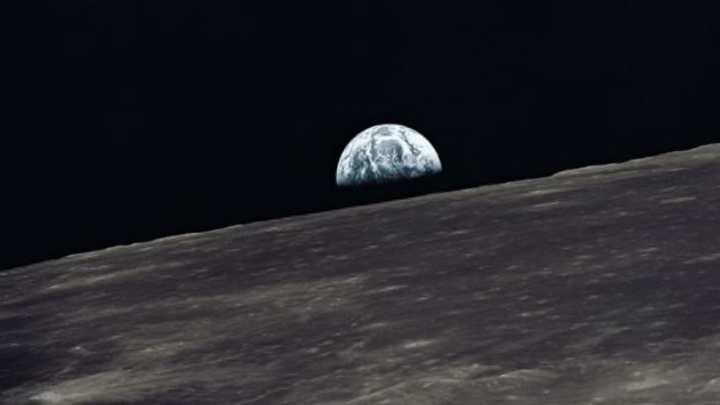The astronauts on NASA’s Apollo 10 mission in May 1969 paved the way for a pivotal moment in human history. But in the process, they introduced an entirely new kind of space exploration mystery.
Apollo 10 served as a test run for Apollo 11's historic moon landing two months later. NASA went through all the same motions and procedures as the landing would require, but came just short of actually touching down on the lunar surface. The three astronauts onboard helped NASA understand the issues that might arise during the real lunar landing. Such as: What happens when a turd floats through the spacecraft?
It was day six of the mission. Commander Tom Stafford noticed it first. “Oh—who did it?” he asked, laughing. “Who did it?”
“Give me a napkin quick,” he told the others. “There’s a turd floating through the air.”
Screenshot via NASA
Talk quickly turned to whose poop it could be, resulting in a pretty hilarious chorus of “not me!”
“I didn’t do it. It ain’t one of mine,” said command module pilot John Young. Lunar module pilot Eugene Cernan claimed, “I don’t think it’s one of mine,” while Stafford was more specific in his denials. “Mine was a little more sticky than that,” he told the others.
Figuring out how astronauts could answer nature’s call was a major challenge NASA had to face if it wanted to keep astronauts in space for more than a few hours. Unfortunately for space travelers trapped in close quarters, the human body experiences “decreased gastrointestinal transit time” in weightless conditions—meaning astronauts go more in space. These days, astronauts on the International Space Station have a vacuum-powered toilet equipped with a seat belt. In the early days of space travel, there were no such luxuries.
In 1961, astronaut Alan Shepard—the first American to travel into space—spent five hours waiting for his 15-minute long Freedom 7 flight. He ended up having to pee in his space suit—something NASA had not prepared for. Later, they added waste collection devices [PDF], but they weren’t foolproof. In 1963, several systems within astronaut Gordon Cooper’s Project Mercury capsule failed due to a leaky urine bag. (To reduce the need to pass solid waste during the Mercury missions, astronauts were fed a special low-fiber diet for the three days before launch.)
An early fecal collection device for astronauts. Image Credit: NASA
But of course, everybody needs to poop eventually. During the longer Apollo missions, astronauts essentially had to use an adhesive plastic bag they could attach to their butt. A germicidal tablet inside killed bacteria to prevent gasses from building up inside the bag.
“In all cases, the primary problem has been the separation, in a weightless environment, of the fecal wastes from the crewmen,” NASA wrote in an analysis of the Apollo fecal collection system in 1972 [PDF]. With no gravity, it’s hard to get your poop away from your body, and it came with a “finger cot” (like a condom for the finger) to help move the poop into the bag. The bag was not popular with astronauts: “Nothing has proved more effective than the current system, which has proved adequate for all flights, although the crewmen have expressed dislike for it.”
As to who unleashed the Apollo 10’s mysterious turd, none of the astronauts on board copped to it. “Well, babe, if it was me, I sure would know I was s****ing on the floor,” Cernan said. The other astronauts continued to claim their own bowel movements were too sticky to be the offender, as evidenced by their experiences with the beloved finger cot. Who really unleashed the Apollo 10 poop rocket, we may never know.
Once NASA astronauts did touch down on the moon, of course, they elected to leave their bags of feces there. Go ahead and search “turd” in the Apollo 10 transcripts to find more astronaut poop jokes.
[h/t: Vox]
